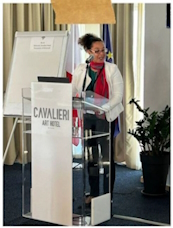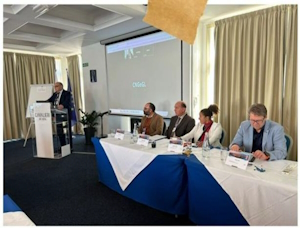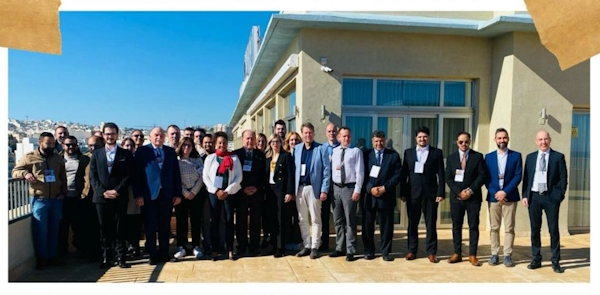

News in 2024
|
This workshop, a joint event of Commissions 3 and 9, aimed to map and bridge the gap that exists in the lifecycle of data collection and management, facilitating land and cadastre valuation. The workshop commenced on the afternoon of February 5 with a welcome reception organized by the European Group of Surveyors (EGoS) and representatives of FIG Commissions 3 and 9, alongside the warm hospitality of the Malta Institute of Surveyors (MIoS) officiated by Mr. Randolph Camilleri and Mr. Alan Micallef.
The first day started with a Welcome Session for the 40 workshop delegates and participants. The speakers included Mr. Nikos Zacharias, the President of EGoS, who warmly welcomed all 40 participants; Mr. Alan Micallef, the previous delegate to the FIG YSN and current President of MIoS, expressed his gratitude for hosting the workshop; Mrs. Diane Dumashie, President of FIG, welcomed everyone, both newcomers and veterans, reminding them of FIG's vision and mission for today and tomorrow; Dr. Sagi Dalyot, Chair of FIG Commission 3, attended the opening session online and illustrated the critical role of spatial data and spatial information management in numerous applications, particularly in land management and valuation; Mr. Peter Ache, Chair of FIG Commission 9, introduced his work plan for his term and outlined the efforts needed for a more transparent real estate market.
The Plenary Session was a dedicated forum focused on the pivotal role of surveyors within the global landscape. Dr. Diane Dumashie spearheaded the session, elucidating FIG vision for 2030 and emphasizing the paramount importance of collaborative efforts in Land Governance. She underscored the necessity of a proactive stance in confronting global challenges for the betterment of society, stressing the indispensability of connectivity and continuity in upholding the integrity of our profession.
Following Dr. Dumashie's insights, FIG past-President, Prof. Chrissy Potsiou, delved into the surveyors' role within the framework of UNECE (United Nations Economic Commission for Europe), providing a comprehensive overview of the current landscape and ongoing research pertaining to land policies and economies. She concluded her address by announcing the forthcoming UNECE Workshop scheduled for 2025, aiming to further explore and address pertinent issues in this domain.
Mr. John Hohol, FIG Foundation President Emeritus, extended a warm welcome to the attendees, underscoring the FIG Foundation's dedication to supporting Young Surveyors and nurturing generational continuity within the surveying profession. Notably, the presence of several Young Surveyors at the workshop was made possible through the steadfast support of the FIG Foundation, reflecting its commitment to fostering the development and engagement of emerging talent within the field.text
 |
 |
Overall, the Technical Sessions underscored the importance of innovation, collaboration, and adaptation within the surveying profession, particularly in the context of emerging technologies and evolving societal needs.
The first day concluded with a captivating tour of the old capital of Medina, a historic fortified city nestled in the heart of Malta. Medina exudes an ambiance steeped in rich history and diverse cultures, offering visitors a glimpse into its storied past while seamlessly adapting to the evolving environment beyond its ancient walls. The tour provided participants with a unique opportunity to immerse themselves in the timeless charm and architectural splendor of this historic gem, further enhancing their understanding and appreciation of Malta's cultural heritage.

The key theme for Day 2 of the workshop was planning, encompassing spatial planning, urban planning, and disaster planning. Technical sessions centered on utilizing geospatial data for planning purposes. The sessions featured research and notable outcomes showcasing the practical application of new technologies in generating geospatial data for use in land administration systems, managing complex land parcels, monitoring mobility, and preserving architecture. Highlights and key takeaways include:
In conclusion, this year’s FIG Commissions 3 & 9 and EGoS Joint Workshop served as a compelling convergence of knowledge from two pivotal sectors within our profession, acting as the ideal nexus between Valuation and Spatial Information Management. Despite not having been thoroughly explored in recent times, our societies and communities, driven partially by economic capacity, must acknowledge the escalating necessity for accurate geospatial and location data. Such data not only facilitates enhanced urban planning and economic growth but also contributes to architectural preservation, fosters healthier tourism, and ensures food stability and secure land tenure. In doing so, unnecessary expenditures can be reduced, and the adverse impact of urban decay on the environment mitigated.
Infinite gratitude is owed to the Organizing Committee for orchestrating such an insightful event, particularly to Randolph Camilleri, Malcolm Elliott, Maria Scorza, Nikos Zacharias, Peter Ache, Sagi Dalyot, Rahmi Celik, and Enrico Rispoli.
In summary:

Report authored by Cromwell Manaloto and edited by Sagi Dalyot.
Photographs captured by Cromwell Manaloto (https://www.linkedin.com/in/cromwell-manaloto-90123447/)
February 2024